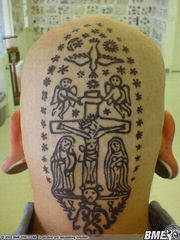Coptic Tattoo's: Difference between revisions
Jump to navigation
Jump to search
(Created page with "<html><div class="mw-content-ltr" dir="ltr" id="mw-content-text" lang="en"><div class="thumb tright"><div class="thumbinner" style="width:182px;"><a class="image" href="/index.php?title=File:CopticTattoo.jpg"><img alt="" class="thumbimage" height="240" src="/images/thumb/9/97/CopticTattoo.jpg/180px-CopticTattoo.jpg" width="180"/></a> <div class="thumbcaption"><div class="magnify"><a class="internal" href="/index.php?title=File:CopticTattoo.jpg" title="Enlarge"><img alt="...") |
(Page conversion via llm-mediawiki-rev -jwm) |
||
| Line 1: | Line 1: | ||
[[File:CopticTattoo.jpg|thumb|right|180px|Coptic Tattoo]] | |||
The '''Coptics''' are a branch of the Christian religion centered in Egypt. Whilst Christianity per se is not against [[Tattoo|tattooing]], they do not actively encourage it. Not so with the Coptic Church: Tattoos were a part of their religious life with different tattoos showing which pilgrimage the wearer had made. In some cases a Priest was the only person allowed to place that particular tattoo (for example the journey to the "Holy Land"). This also was believed to ensure a [[Christian|Christian]] burial. | |||
Latest revision as of 01:59, 17 September 2023
The Coptics are a branch of the Christian religion centered in Egypt. Whilst Christianity per se is not against tattooing, they do not actively encourage it. Not so with the Coptic Church: Tattoos were a part of their religious life with different tattoos showing which pilgrimage the wearer had made. In some cases a Priest was the only person allowed to place that particular tattoo (for example the journey to the "Holy Land"). This also was believed to ensure a Christian burial.
